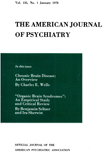SOME MOTOR ASPECTS OF SCHIZOPHRENIA: AN EMG STUDY
Abstract
1. The value of studying motor activity in mental illness should not be overlooked. Motor activity within the central nervous system is intimately tied up with sensation, emotion, and thinking. An understanding of the neurophysiology of any one of these, as well as their deviations in illness, must include a description of the motor component.
2. Multi-channel electromyographic measurements on 21 schizophrenic patients and 10 control subjects are here reported. An electromyograph giving both integrated and instantaneous readings and capable of measuring minute amounts of motor activity was employed. Residual motor activity was recorded while the subjects endeavored to relax as completely as possible in the supine position. This residual motor activity is for the most part invisible to the naked eye.
Records were taken simultaneously from 4 muscle areas, namely forehead, jaw, forearm, and leg, for 30-minute periods. The patients exhibit higher levels of motor activity in all 4 muscle areas and the differences between these and the values for the control group are highly significant (P=<0.00l for forehead and jaw, and P=<0.01 for forearm and leg). Quantitatively these differences are remarkably similar for each muscle area. The grand mean for the patient group is 54.9 units of motor activity and for the control group 19.9 units.
3. This exaggerated motor activity is most likely accompanied by increased activity in efferent neurons of the motor cortex and/or premotor cortex. Such increased pyramidal cell activity could have widespread influence on the functioning of the cerebral cortex, as well as subcortical structures, through the agency of the many collateral fibers given off by these neurons. Since there is evidence that both thinking and emotion have motor components, it is reasonable that hyperactivity in the motor system might lead to disturbances of thinking and emotion. The possibility of motor system hyperactivity playing an etiological role of some type in the onset of schizophrenia should be kept in mind.
4. The term "hyperponesis" is suggested to refer to exaggerated activity within the motor portion of the central nervous system. This exaggerated activity may be localized to a portion of the motor system or generalized to include the whole motor system, it may be intermittent or continuous, static or phasic, overt or invisible.
Access content
To read the fulltext, please use one of the options below to sign in or purchase access.- Personal login
- Institutional Login
- Sign in via OpenAthens
- Register for access
-
Please login/register if you wish to pair your device and check access availability.
Not a subscriber?
PsychiatryOnline subscription options offer access to the DSM-5 library, books, journals, CME, and patient resources. This all-in-one virtual library provides psychiatrists and mental health professionals with key resources for diagnosis, treatment, research, and professional development.
Need more help? PsychiatryOnline Customer Service may be reached by emailing [email protected] or by calling 800-368-5777 (in the U.S.) or 703-907-7322 (outside the U.S.).



